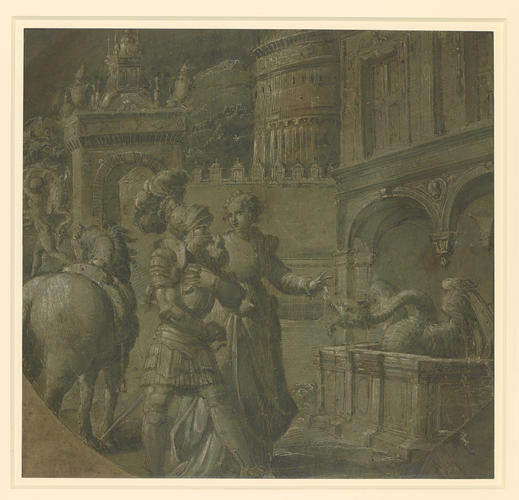-
1 of 253523 objects
A scene from Orlando innamorato: Brandimarte in the enchanted palace c.1545
Pen and ink with dark green wash and white heightening, on green prepared paper; the outlines pricked | 33.2 x 34.9 cm (sheet of paper) | RCIN 906317
-
The drawing illustrates a passage from Matteo Maria Boiardo’s verse-romance Orlando innamorato. On entering a palace, the hero Brandimarte was challenged to open a tomb and to kiss whatever emerged. Out of the tomb came a dragon, but when Brandimarte plucked up the courage to kiss the dragon it turned into a fairy.
This drawing is one of four known by Nicolò dell’Abate in a similar format, on courtly or chivalric themes; the others are in the Uffizi, the Louvre (no. 20746) and the Getty. A fifth scene is known through an old copy in Munich. All were initially circular in format - a compass point here lies above the lady’s shoulder, and the drawing has been made up to a near square by reusing an excised portion of the upper part of the drawing at lower right. The original form of the composition can be seen in an old copy in an album of drawings in Modena.
The Royal Collection and Uffizi drawings have been convincingly identified as illustrations to Book 2 of Orlando innamorato, left unfinished at Boiardo’s death in 1494 and first published the following year. The Windsor drawing illustrates the passage from Canto xxv, octave 23 to Canto xxvi, octave 17. In that episode Brandimarte and Fiordelisa reach a palace, where a maiden stands at a balcony signalling that they should pass by and not enter. Instead Brandimarte approaches, and inside finds a giant struggling with a serpent. Brandimarte battles at length with the giant, who uses the serpent as his weapon - the giant brandishing the serpent is visible in the left background of the drawing, and Brandimarte with his sword drawn was trimmed off when the drawing was squared up.
After Brandimarte triumphs over the giant, he finds that the door through which he had entered has vanished. Eventually the maiden they saw earlier appears. She asks Brandimarte to take courage, to open a tomb that lies in the courtyard, and to kiss whatever emerges. Brandimarte thinks nothing of this task, but when he forces open the tomb a dragon emerges, its mouth gaping. The knight steps back in amazement and puts his hand to his sword, but the maiden implores him to kiss the serpent or he will die. Gradually Brandimarte edges closer, and when he finally kisses the dragon it turns into the fairy who built the palace, who explains that when a fairy has lived for a thousand years she is transformed into a dragon until kissed by someone brave.
Before moving to the French court at Fontainebleau, Nicolò dell’Abate worked in and around Modena and Bologna, specialising in decorative schemes on pastoral, courtly and literary themes. He seems to have executed three decorative schemes on the subject of Orlando during the 1540s. Only one survives in part, formerly in the Palazzo Torfanini in Bologna and now in the Pinacoteca, in which the scenes take place in tall arched landscapes. Two earlier cycles are mentioned in documents: a series of 'favole del Furioso' for Giulio Boiardo, descendent of Matteo Maria, in the castle at Scandiano (perhaps confusing Ariosto’s Orlando furioso with Boiardo’s Orlando innamorato); and the decoration of the Palazzo Ducale at Sassuolo, about which the documentation is unclear, referring variously to a room known as ‘dell’Orlando’ and ‘delle Pazzie d’Orlando’, and to a room adorned with five ovato (literally ‘oval’) framed paintings by Abate of unspecified subjects.
The coincidence of the number of paintings in this last scheme with the number of known compositions from the series under discussion is striking, but the multiplicity of probable literary sources argues against the drawings being connected with a single cycle. Further, the Louvre drawing is distinct in style and technique from the other three autograph sheets. The pricking of the outlines of most of the drawings indicated that they were to be reproduced on the same scale (and thus too small for fresco decoration) and, given their circular format, suggested that the drawings were models for painted maiolica plates. On the same grounds, and given their monochrome chiaroscuro effects, it has been proposed that they may rather have been models for the decoration of parade armour. In the absence of any comparable surviving works after designs by Abate it is impossible to be certain, but the pricking and diversity of style do seem to indicate that this ‘series’ of drawings in fact comprises a number of distinct projects, testifying to the vogue for these romantic tales in sixteenth-century Emilia.
Catalogue entry adapted from The Art of Italy in the Royal Collection: Renaissance and Baroque, London, 2007Provenance
Presumably in the Royal Collection by c.1810
-
Creator(s)
-
Medium and techniques
Pen and ink with dark green wash and white heightening, on green prepared paper; the outlines pricked
Measurements
33.2 x 34.9 cm (sheet of paper)
Category
Object type(s)
Other number(s)
